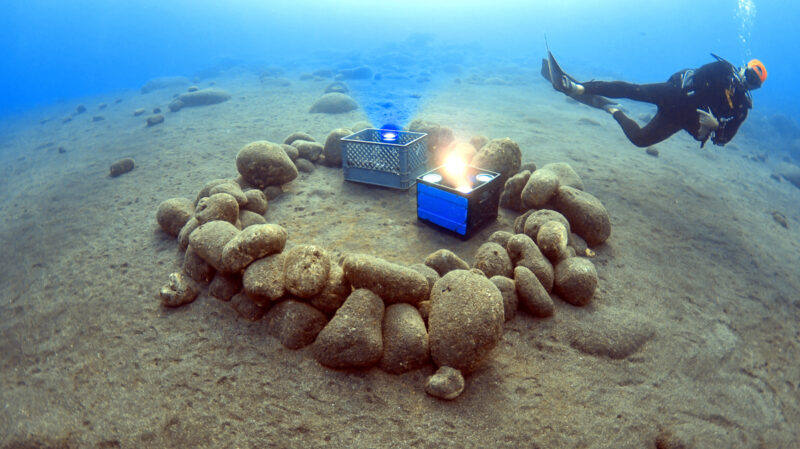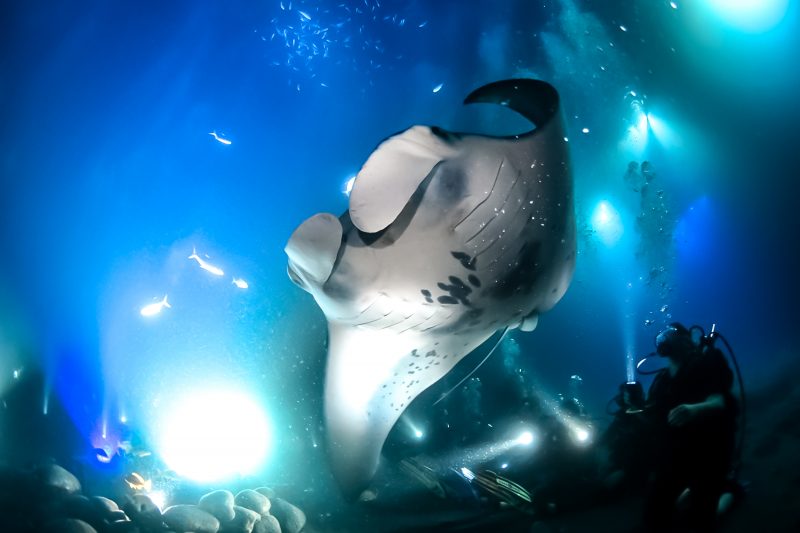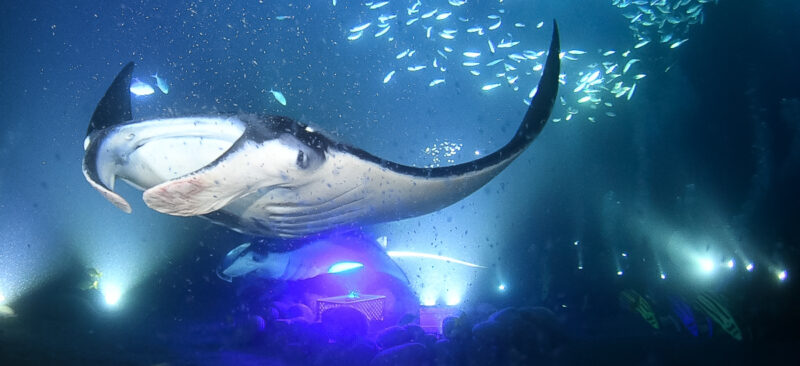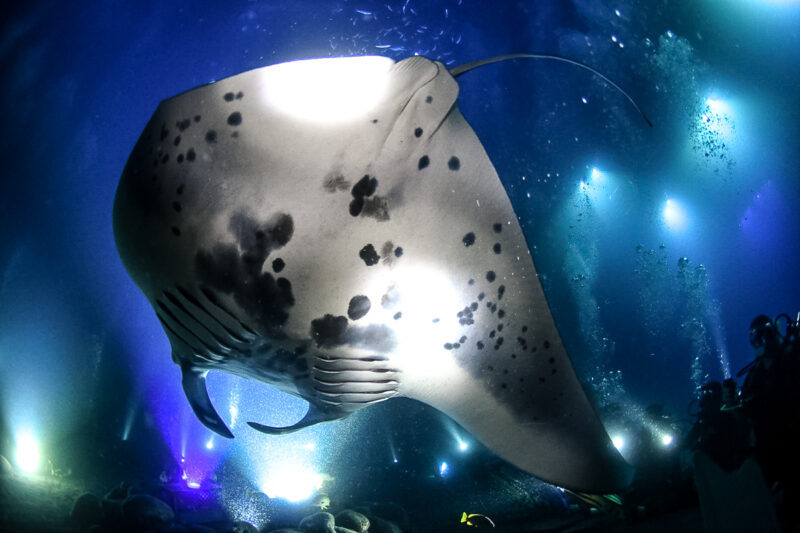Go on an extraordinary underwater adventure by diving with Manta Rays in the pristine waters of Kona, Hawaii. This unique and thrilling experience allows you to witness the majestic beauty of these graceful creatures in their natural habitat. Kona is renowned for its rich marine life, and diving with Manta Rays is a highlight that attracts enthusiasts from around the world.
As you plunge into the depths of the Pacific Ocean, the magic unfolds beneath the moonlit surface. Imagine the awe-inspiring moment when you find yourself surrounded by these gentle giants, their wings gracefully gliding through the water. Diving with Manta Rays in Kona offers an intimate encounter with these magnificent creatures, creating memories that will last a lifetime. The ethereal dance of the mantas, illuminated by underwater lights, adds a touch of enchantment to this unparalleled diving experience in the Hawaiian paradise.
Diving in the Kona Quick Information
- Wet Suit: 3mm / Shortie / Skin
- Water Temperature: Average 30 surface, 28 bottom
- Current: Minimal
- Average Depths: 10m
Manta Season in the Kona
Explore the enchanting world of Manta Rays in Kona, Hawaii, where the Manta season extends throughout the year, offering enthusiasts continuous opportunities to witness these magnificent creatures. Kona stands out for its unique Manta Ray Night Dive and Snorkel experiences, with popular sites like the Manta Ray Village near the Sheraton Kona Resort & Spa at Keauhou Bay becoming iconic destinations for underwater encounters.
While the Manta season is year-round, the activity and abundance of mantas can fluctuate based on various factors such as water temperature, food availability, and environmental conditions. Generally, the summer months, from May to September, mark a peak in Manta activity. During this period, plankton concentrations rise, creating a banquet for mantas and attracting them to the well-lit areas where divers and snorkelers congregate. This natural phenomenon adds an extra layer of excitement to the Kona Manta experience, setting it apart from other locations around the globe.
Recommended Certifications for Manta Dive at Kona
The Manta Ray Dive at Kona is about as simple as they can get. While there is the added element of being night, there will be enough flash nights to make even a nervous diver feel confident. For that reason, the only certification you really need to complete this dive is:
- Open Water Certification
What to Expect During the Manta Ray Dive at Kona
Depending on what company that you attend the dive with there are a couple of ways that the dive is going to be completed.
Some companies over a two evening dives, such as the Big Island Divers. In this case, you will do one dive before the sun has set and this is like an orientation dive. You will see the Garden of Eels, a bunch of garden eels out in the sand, and then dive about the area looking for little critters. During this evening dive, there is also a chance to see Manta Rays passing by in the distance, but the primary purpose of this dive is more of an orientation dive.
This evening dive is also used by tour groups to set up the “campfire” which I will discuss more in the next section.
There are other options of just signing up for the one night dive. In this case, you will arrive at the location once the sun has set and then just receive a dive brief prior to jumping in the water.
If you are a nervous night diver, then the two evening dives may be the better option for you so that you can grow accustomed to the environment before going in at night.
If you are a confident diver and have some night dives under your belt, then the one night dive is a more cost-effective way to see the Manta Rays.

As the sun is setting your divemaster will start giving the dive brief and the orientation for the dive. There will also be a brief of fun facts about Manta Rays. If you do the dive twice, you will hear the same jokes twice.
The dive is pretty straight forward, you will exit the boat with a torch. The light will remain on at all times.
After your group has gathered, and you are ready to descend you will then swim over to what is called “the campfire”. The campfire is a collective of high beam torches in the center of a rock circle – kind of looking like a flashlight campfire.
Once you have arrived at the campfire you will be positioned around it by the divemaster. You can either kneel down or sit down on the sand. If you are having issues staying down, the divemaster may put a rock in your lap to keep you still in the slight rock of the current.
Once you are positioned on the sand, you will spend the remaining of the time in that position. So the hardest part of the dive is basically done. From here now, you just sit with your torch held up over your head.
The Manta Rays will come through the “campfire” eating the plankton that has accumulated in the light. Additionally, they will pass over the divers head entering or exiting the area of the campfire.
This varies from night to night. During my two dives there we at most saw two Mantas at the campfire at a time. However, there are other swimming around in the dark in the outer circle area. Reports on other days stated the appearance of upwards of 20 Mantas at the location. So it really does vary.
While these Mantas are local, there is always the possibility of being a low turn out as the manta rays are still wildlife.
There are two different dive locations: “Manta Heaven”, and “Manta Village” that are used with the same concept across Kona. The location we went to, Manta Heaven, – near the Kona Airport – was visited by approximately 3 or 4 other dive companies, and then approximately 4 snorkeling groups.
The campfire can be crowded. There will be people fully encircling the campfire at about 20 feet away from the campfire. I would say there are approximately 40 people down there at peak time.
Interesting Facts about Manta Rays
Manta Rays are fascinating creatures with a range of interesting facts that contribute to their allure:
- Gentle Giants: Despite their large size, Manta Rays are known as gentle giants. They are filter feeders, primarily consuming plankton and small fish, and pose no threat to humans.
- Impressive Size: Manta Rays boast an impressive wingspan, with some individuals reaching up to 23 feet (7 meters). This large size makes them one of the largest species of rays.
- Distinctive Appearance: Manta Rays are easily recognizable by their unique appearance, featuring triangular pectoral fins, cephalic lobes extending forward from their heads, and wide, flattened bodies.
- Long Lifespan: These majestic creatures have a relatively long lifespan, with some Manta Rays living up to 50 years. Their slow growth rate and late maturity contribute to their extended life expectancy.
- Curious Behavior: Manta Rays are known for their curious nature and may approach divers and snorkelers. This behavior has led to unforgettable interactions and close encounters with these magnificent marine animals.
- Manta Ray Vocabulary: Researchers have identified specific sounds associated with Manta Rays, suggesting a form of communication among individuals. These vocalizations may play a role in social interactions or mating behaviors.
- Global Distribution: Manta Rays can be found in various warm-water oceans across the globe. Different species include the Reef Manta Ray and the Giant Manta Ray, each with its distinct characteristics.
- Migratory Patterns: Manta Rays exhibit migratory patterns, traveling across vast distances in search of food and suitable breeding grounds. Understanding these migration routes is crucial for conservation efforts.
- Vulnerability to Threats: Despite their strength and size, Manta Rays are vulnerable to human-induced threats. They face challenges such as entanglement in fishing gear, habitat loss, and the demand for their gill plates in traditional medicine.
- Conservation Efforts: Recognizing the need for conservation, many organizations and initiatives focus on protecting Manta Rays. Efforts include promoting responsible tourism, advocating for marine protected areas, and conducting research to better understand and conserve these remarkable marine species.
Where else can I dive with Manta Rays?
Diving enthusiasts have the opportunity to encounter Manta Rays in various locations around the world. Some notable destinations known for Manta Ray encounters include:
- Maldives: The Maldives is renowned for its clear waters and diverse marine life, including Manta Rays. Popular dive sites such as Hanifaru Bay attract these gentle giants, especially during the southwest monsoon season.
- Indonesia: Several locations in Indonesia offer incredible Manta Ray encounters. Komodo National Park, Raja Ampat, and Nusa Penida are among the top spots where divers can witness these majestic creatures.
- Palau: Palau, in the western Pacific, is famous for its thriving marine ecosystem. Manta Rays can be spotted at cleaning stations, where smaller fish help rid them of parasites.
- Thailand: The Similan Islands and Koh Bon in Thailand are known for Manta Ray sightings. Divers can explore these vibrant underwater landscapes while encountering these graceful marine animals.
- Hawaii (Maui): In addition to the Kona region, Maui in Hawaii is another popular location for Manta Ray dives. Night dives in particular offer a unique opportunity to witness these rays feeding in their natural environment.
- Ecuador (Galápagos Islands): The Galápagos Islands are a UNESCO World Heritage Site and home to unique marine life, including Manta Rays. Divers visiting Darwin and Wolf Islands may have the chance to dive with these captivating creatures.
- Australia (Great Barrier Reef): The Great Barrier Reef is not only famous for its coral formations but also attracts Manta Rays. Certain areas along the reef provide excellent opportunities for underwater encounters.
- Mexico (Revillagigedo Islands): The Revillagigedo Islands, often referred to as the Socorro Islands, are known for pelagic encounters, including Manta Rays. Liveaboard trips to these remote islands offer a chance to witness these marine wonders.
- Fiji: Fiji’s nutrient-rich waters are a magnet for Manta Rays. Sites like the Manta Ray Pass in Kadavu provide thrilling opportunities for divers to witness these graceful giants.
- Malaysia (Sipadan): Sipadan, located in the Celebes Sea, is known for its rich marine biodiversity. While divers come to witness diverse marine life, Manta Rays are occasionally spotted in the area.
Dive Shops for the Manta Ray Dive at Kona
There are a lot of shops that offer the night-time dive, or snorkel. Here are some of the most popular ones:
- Big Island Divers – this is the company that I used. The one tank will cost you $139.
- Kona Honu Divers
- Manta Ray Dives





Hello there! Thanks for sharing your scuba diving experience. The Manta Ray Dive at Kona. The information about Water Temperature, location, the Closest Airport is very helpful for the person who visit there 1st time. Keep posting!
[…] Manta Ray Dive at Kona – The Big Island […]
[…] Manta Ray Dive at Kona – The Big Island […]
[…] Manta Ray Dive at Kona – The Big Island […]
I’ve never done one of these dives before. We are planning a trip soon so I think we’ll see about doing this. I really like the method you use to attract the rays by using high powered lights as a “campfire” and then they feed off the plankton that goes towards the lights.
[…] Manta Ray Dive at Kona – The Big Island […]